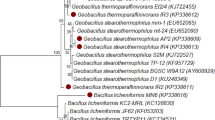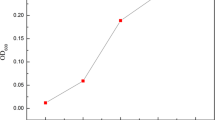Abstract
Biocorrosion is a frequent problem in oil and gas industry that occurs due to the ubiquitous nature of the microorganisms. The main objective of this study is to identify corrosive bacterial strains from crude oil reservoir samples and elucidation of their role in the biocorrosion of carbon steel API 5LX. Pure bacterial strains were identified using both biochemical and 16S rRNA gene sequencing methods. Identified dominant strains were subjected to weight loss and electrochemical studies. The Gram-positive bacteria Bacillus subtilis A1 and Bacillus cereus A4 were identified as dominant species. Corrosion rates were 0.743, 0.594 and 0.297 mm/year in the presence of strain B. subtilis A1, B. cereus A4 and abiotic control system, respectively. The charge transfer resistance values show a continuous decrease in the presence of bacterial culture indicating that formation of the heterogeneous biofilm and iron oxide over the metal surface leads to the corrosion phenomenon. Surface analysis techniques including X-ray diffraction, scanning electron microscopy and atomic force microscopy examination reveal the ability of bacteria to oxidize iron/manganese to their corresponding oxides, leading to the formation of thick biofilm on metal surface and accelerating the pitting corrosion of carbon steel.








Similar content being viewed by others
References
Beech IB, Sunner JA (2004) Biocorrosion, towards understanding interactions between biofilms and metals. Curr Opin Biotechnol 15:181–186
Rajasekar A, Ganesh Babu T, Karutha Pandian S, Maruthamuthu S, Palaniswamy N, Rajendran A (2007) Biodegradation and corrosion behavior of manganese oxidizer Bacillus cereus ACE4 in diesel transporting pipeline. Corros Sci 49:2694–2710
Narenkumar J, Madhavan J, Nicoletti M, Benelli G, Murugan K, Rajasekar A (2016) Role of bacterial plasmid on biofilm formation and its influence on corrosion of engineering materials. J Bio Tribo Corros 2:24
Rajasekar A, Xiao W, Sethuraman M, Parthipan P, Elumalai P (2017) Airborne bacteria associated with corrosion of mild steel 1010 and aluminum alloy 1100. Environ Sci Pollut Res. doi:10.1007/s11356-017-8501-z
Fouda AS, Shalabi K, Hossiany AE (2016) Moxifloxacin antibiotic as green corrosion inhibitor for carbon steel in 1 M HCl. J Bio Tribo Corros 2:18
Jafari H, Akbarzade K (2017) Effect of concentration and temperature on carbon steel corrosion inhibition. J Bio Tribo Corros 3:8
Cote C, Rosas O, Sztyler M, Doma J, Beech I, Basseguy R (2014) Corrosion of low carbon steel by microorganisms from the ‘pigging’ operation debris in water injection pipelines. Bioelectrochemistry 97:97–109
Mehana M (2009) Mecanismes de transfert direct en corrosion microbienne des aciers: application a Geobacter sulfurreducens et a l’hdrogénase de Clostridium acetobutylicum (Thesis Université de Toulouse)
Flemming HC (1996) Biofouling and microbiologically influenced corrosion (MIC): an economical and technical overview. In: Heitz E, Flemming HC, Sand W (eds) Microbiologically influenced corrosion of materials-scientific and engineering aspects. Springer, Heidelberg
Rajasekar A, Ganesh Babu T, Karutha Pandian S, Maruthamuthu S, Palaniswamy N, Rajendran A (2007) Role of Serratia marcescens ACE2 on diesel degradation and its influence on corrosion. J Ind Microbiol Biotechnol 34:589–598
Hamilton WA (2003) Microbially influenced corrosion as a model system for the study of metal microbe interactions: a unifying electron transfer hypothesis. Biofouling 19:65–76
Lenhart RT, Duncan KE, Beech IB, Sunner JA, Smith W, Bonifay V, Biri B, Suflita JM (2014) Identification and characterization of microbial biofilm communities associated with corroded oil pipeline surfaces. Biofouling 30:823–835
Kerr A, Cowling MJ, Beveridge CM, Smith MJ, Parr ACS, Head RM, Davenport J, Hodgkiess T (1998) The early stages of marine biofouling and its effect on two types of optical sensors. Environ Int 24:331–343
Okoro C, Smith S, Chiejina L, Lumactud R, An D, Park HS, Voordouw J, Lomans BP, Voordouw G (2014) Comparison of microbial communities involved in souring and corrosion in offshore and onshore oil production facilities in Nigeria. J Ind Microbiol Biotechnol 41:665–678
Herrera LK, Videla HA (2009) Role of iron-reducing bacteria in corrosion and protection of carbon steel. Int Biodeterior Biodegrad 63:891–895
Dihn HT, Kuever J, Mubmann M, Hassel AW, Stratmann M, Widdel F (2004) Iron corrosion by novel anaerobic microorganisms. Nature 427:829–832
Kuhr VW, Van der Vlugt LS (1934) Graphication of cast iron as an electrochemical process in anaerobic soils. Water 16:147–165
Zhu XY, Lubeck J, Kilbane JJ (2003) Characterization of microbial communities in gas industry pipelines. Appl Environ Microbiol 69:5354–5363
Rajasekar A, Maruthamuthu S, Muthukumar N, Mohanan S, Subramanian P, Palaniswamy N (2005) Bacterial degradation of naphtha and its influence on corrosion. Corros Sci 47:257–271
Raikos V, Vamvakas SS, Kapolos J, Koliadima A, Karaiskakis G (2011) Identification and characterization of microbial contaminants isolated from stored aviation fuels by DNA sequencing and restriction fragment length analysis of a PCR-amplified region of the 16S rRNA gene. Fuel 90:695–700
Islam MA, Farhat ZN (2015) Mechanical and electrochemical synergism of API X42 pipeline steel during erosion–corrosion. J Bio Tribo Corros 1:26
Fouda AS, Mohamed FS, El-Sherbeni MW (2016) Corrosion inhibition of aluminum–silicon alloy in hydrochloric acid solutions using carbamidic thioanhydride derivatives. J Bio Tribo Corros 2:11
Ornek D, Jayaraman A, Syrett BC, Hsu CH, Mansfeld FB, Wood TK (2002) Pitting corrosion inhibition of aluminum 2024 by Bacillus biofilms secreting polyaspartate orc-polyglutamate. Appl Microbiol Biotechnol 58:651–657
Kuruvilla M, Prasad AR, John S, Joseph A (2017) Enhanced inhibition of the corrosion of metallic copper exposed in sulphuric acid through the synergistic interaction of cysteine and alanine: electrochemical and computational studies. J Bio Tribo Corros 3:5
Perumal S, Muthumanickam S, Elangovan A, Karthik R, Sayee kannan R, Mothilal KK (2017) Bauhinia tomentosa leaves extract as green corrosion inhibitor for mild steel in 1 M HCl medium. J Bio Tribo Corros 3:13
Wadood HZ, Rajasekar A, Ting YP, Sabari AN (2015) Role of Bacillus subtilis and Pseudomonas aeruginosa on corrosion behaviour of stainless steel. Arab J Sci Eng 40:1825–1836
Rajasekar A, Anandkumar B, Maruthamuthu S, Ting YP, Rahman PKSM (2010) Characterization of corrosive bacterial consortia isolated from petroleum product transporting pipelines. Appl Microbiol Biotechnol 85:1175–1188
Holt JG, Kreig NR, Sneath PHA, Stanely JT (1994) Bergey’s manual of determinative bacteriology. Williams and Wilkins Publishers, Maryland
Ausubel FM, Brent R, Kingston RE, Moore DD, Seidelman JG, Struhl KE (1988) Current protocols in molecular biology. Wiley, New York
Altschul SF, Gish W, Miller W, Myers EW, Lipman DJ (1990) Basic local alignment search tool. J Mol Biol 215:403–410
San NO, Nazir H, Donmez G (2011) Microbial corrosion of Ni–Cu alloys by Aeromonas eucrenophila bacterium. Corros Sci 53:2216–2221
Rajasekar A, Balasubramanian R, Kuma JVM (2011) Role of hydrocarbon degrading bacteria Serratia marcescens ACE2 and Bacillus cereus ACE4 on corrosion of carbon steel API 5LX. Ind Eng Chem Res 50:10041–10046
Rajasekar A, Ting YP (2010) Microbial corrosion of aluminum 2024 aeronautical alloy by hydrocarbon degrading bacteria Bacillus cereus ACE4 and Serratia marcescens ACE2. Ind Eng Chem Res 49:6054–6061
Rajasekar A, Maruthamuthu S, Ting YP (2008) Electrochemical behavior of Serratia marcescens ACE2 on carbon steel API 5L-X60 in organic/aqueous phase. Ind Eng Chem Res 47:6925–6932
Rajasekar A, Ponmariappan S, Maruthamuthu S, Palaniswamy N (2007) Bacterial degradation and corrosion of naphtha in transporting pipeline. Curr Microbiol 55:374–381
Dandie CE, Thomas SM, Bentham RH, McClure NC (2004) Physiological characterization of Mycobacterium sp. strain 1B isolated from a bacterial culture able to degrade high-molecular-weight polycyclic aromatic hydrocarbons. J Appl Microbiol 97:246–255
Shimura M, Kimbara K, Nagato H, Hatta T (1999) Isolation and characterization of a thermophilic Bacillus sp. JF8 capable of degrading polychlorinated biphenyls and naphthalene. FEMS Microbiol Lett 178:87–93
Jan-Roblero J, Romero JM, Amaya M, Borgne SL (2004) Phylogenetic characterization of a corrosive consortium isolated from a sour gas pipeline. Appl Microbiol Biotechnol 64:862–867
Pillay C, Lin J (2013) Metal corrosion by aerobic bacteria isolated from stimulated corrosion systems: effects of additional nitrate sources. Int Biodeterior Biodegrad 83:158–165
Venzlaff H, Enning D, Srinivasan J, Mayrhofer KJJ, Hassel AW, Widdel F, Stratmann M (2013) Accelerated cathodic reaction in microbial corrosion of iron due to direct electron uptake by sulfate-reducing bacteria. Corros Sci 66:88–96
Li H, Zhou E, Ren Y, Zhang D, Xu D, Yang C, Feng H, Jiang Z, Li X, Gu T, Yang K (2016) Investigation of microbiologically influenced corrosion of the high nitrogen nickel-free stainless steel by Pseudomonas aeruginosa. Corros Sci 111:811–821
AlAbbas FM, Williamson C, Bhola SM, Spear JR, Olson DL, Mishra B, Kakpovbia AE (2013) Microbial corrosion in linepipe steel under the influence of a sulfate-reducing consortium isolated from an oil field. J Mater Eng Perform 22:3517–3529
Duan J, Wu S, Zhang X, Huang G, Du M, Hou B (2008) Corrosion of carbon steel influenced by anaerobic biofilm in natural seawater. Electrochim Acta 54:22–28
Castaneda H, Benetton XD (2008) SRB-biofilm influence in active corrosion sites formed at the steel-electrolyte interface when exposed to artificial seawater conditions. Corros Sci 50:1169–1183
Yuan SJ, Pehkonen SO (2007) Microbiologically influenced corrosion of 304 stainless steel by aerobic Pseudomonas NCIMB 2021 bacteria: AFM and XPS study. Colloids Surf B 59:87–99
Eaton A, Clesceri L, Greenberg A (1995) Standards methods for the examination of water and wastewater, 19th edn. APHA, Washington
Beech IB, Sunner JA, Hiraoka K (2005) Microbes surface interactions in biofouling and biocorrosion processes. Int Microbiol 8:157–168
Little B, Lee JS (2007) Microbiologically influenced corrosion. Wiley, New Jersey
Acknowledgements
A. Rajasekar was thankful to the Department of Biotechnology, Government of India, for the award of Ramalingaswami Re-entry Fellowship (BT/RLF/Re-entry/17/2012), Science and Engineering Research Board, Department of Science and Technology (SB/YS/LS-40/2013 and EEQ/2016/000449) and University Grants Commission-MRP (MRP-MAJOR-MICRO-2013-31825) for the financial supports. Authors also acknowledge the help received from Dr. Ting Yen-Peng and Ms. R. Tulasiya on surface analysis (AFM), and Dr. J. Madhavan, Dr. J. Theerthagiri, Dr. R.A. Senthil, Department of Chemistry, Thiruvalluvar University (TVU), electrochemical studies and related discussions.
Author information
Authors and Affiliations
Corresponding author
Ethics declarations
Conflict of interest
The authors declare that they have no conflict of interest.
Rights and permissions
About this article
Cite this article
Parthipan, P., Babu, T.G., Anandkumar, B. et al. Biocorrosion and Its Impact on Carbon Steel API 5LX by Bacillus subtilis A1 and Bacillus cereus A4 Isolated From Indian Crude Oil Reservoir. J Bio Tribo Corros 3, 32 (2017). https://doi.org/10.1007/s40735-017-0091-2
Received:
Revised:
Accepted:
Published:
DOI: https://doi.org/10.1007/s40735-017-0091-2




